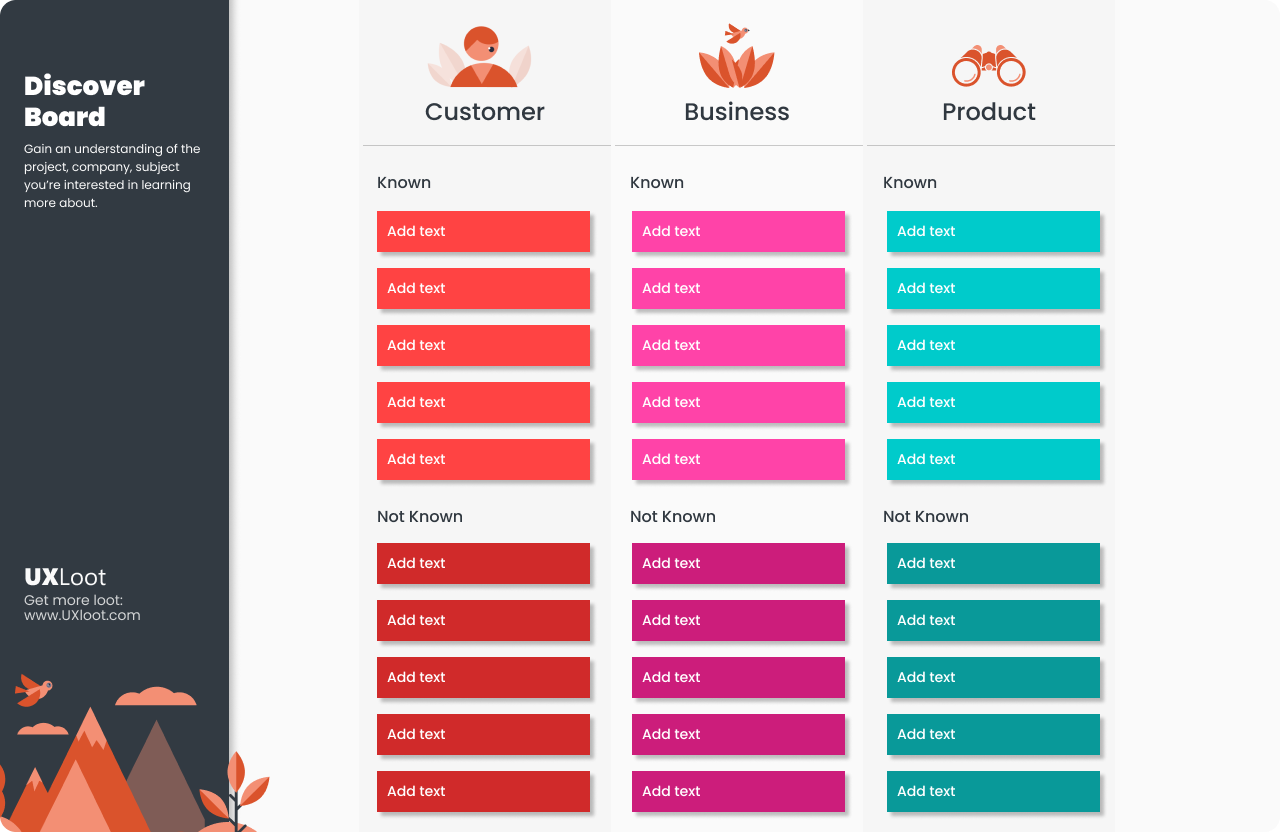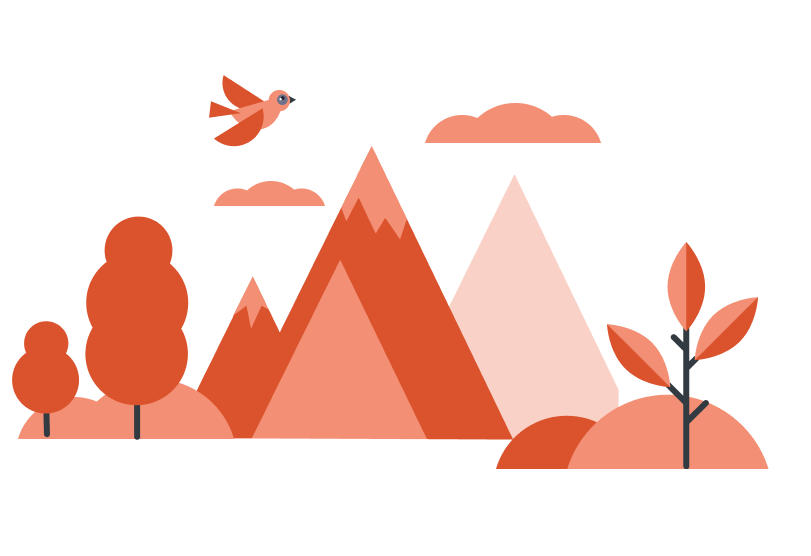The Discover phase of UX can feel overwhelming, especially when a project is first starting. By the end of this this post we’ll have demystified key discovery activities and gotten some hands on practice so you can lead your next discovery phase with confidence.
The world is a vast and wonderful place full of opportunities. We just have to know where and how to look for them. In the Discover phase we are the explorer. We maneuver through a new environment, observe and explore what’s around us. We ground ourselves within the space and immerse ourselves with the people we aim to serve.
Within the Discover phase there are many techniques to pull apart the landscape and uncover insights and opportunities.
We’ll start exploring by answering the most common question when phased with an overwhelming mountain of unknowns. Where do I start?
Where do I start?
Start by naming something you are looking to explore and asking two questions: Question one: “what do we know?” and question two:” what do we not know?”. A name and two questions, already feels simpler, huh?
The simplest way to start exploring something is by giving it a name. The name may change with time but naming it makes it a lot more tangible and manageable. Psychologically speaking, it’s powerful to name things as it helps us simplify, organize, and tame. Rather than feeling overwhelmed by something, it becomes attainable. It belongs to us.
This is an interactive post so let’s just try it.
In the worksheet below name what you’re looking to explore. This can either be a project you’re currently on or a space you already belong to and have first hand knowledge about. Go ahead, give it a go:
✎ Name Worksheet
Discover
Name the space you will be discovering

Remember in the Discover phase we are explorers and explorers… are curious. The key is to be as open minded as possible to get a true assessment of where we stand. Knowing where we stand leads to knowing where we need to go.
To assess where we stand we’ll spend some time asking ourselves (or our teams) two simple yet powerful questions:
- What do we know?
- What do we not know?
This is part of what’s called the “known-unknown framework” in Design Thinking. We won’t get into it deeply here but if you’re curious to learn more about it there are several links in the More on Discover section down below.
Answering what we know and don’t know gives us a sense of where we are which naturally leads us to where we need to go to next. The unknowns help us identify the kind of activities needed to fill in the gaps.
Alright, started with a name and now we’re going to document what we know and don’t know. This can feel overwhelming if we try to do it all at once. That's why we’re going to take it step by step. We’ll take turns down what comes top of mind for customers, business, and product.
Document what is known and unknown

45 ideas in 15 minutes
A simple way to understand what we know and don’t know is with a time-boxed exercise. For each part of the space we are exploring we’ll ask ourselves (or our partners) what do we know? And, what don’t we know?
For example, if the space we are exploring has a business side, some customers, and a product, we would ask ourselves those two questions (what do we know / what don’t we know) three times making a list of our answers . By the end of the exercise we’ll have a list of at least five items for each question across three columns for a total of 30 insights!
Customers: Known-Unknown
Let’s build up that muscle memory by going through the exercise of identifying what we know and don’t know about the customer.
For the purposes of this exercise we’ll assume these are people paying for a value you or your company provides. However it can also apply to an audience or users as well. To learn more about the difference among customers, audience, and users check out the More on Discover section below.
Activity: Discover Customer
- Start a timer to time box the activity.
- Jot down what you KNOW about the customer. Take about 2 minutes to do this. What do they call themselves? What do they like? Dislike? What is their frustration?
- Jot down what you do NOT know about the customer. Take another 2 minutes to jot down what you don’t know. Maybe you don’t know what fustrates them? Why they are not purchasing your product? Or you're not sure who your customers are?
It’s ok if you only have a couple of bullet points for each question but try to aim for 5.
Like everything else in UX remember, there are no wrong answers. Don’t be too hard on yourself or your partners if the answer is ‘we don’t know.’
Why use a timer? Timers are great for time boxing. Time boxing becomes really important in brainstorming activities like this one because the more time we allow ourselves the better we are at making things up. The time box ensures we only jot down things that are truly top of mind.
Let’s get some hands on practice. Use a pen and paper, your favorite whiteboard app, or the interactive worksheets below.
It’s ok to go between the two lists. This is a structured brainstorming exercise so let your mind go where it naturally goes. Start that timer and type in the boxes below!
✎ Customer Worksheet
Customer
Brainstorm what is known and not known about the customer.

We DO know
We DON'T know
Business: Known-Unknown
If you are not the business lead, answering what’s known and unknown about the business can be quite challenging! This is a perfect set of questions to ask your business partners. If you are creating something by yourself (say an app, or even portfolio site) then congrats, you’re the business lead in addition to the UX lead! Let’s get started.
Just like uncovering known and unknowns for customers, we’re going to ask ourselves the same two simple yet powerful questions to uncover knowledge on the business: 1. What do we know about the business? 2. What do we not know about the business?
Activity: Discover Business
- Start the timer.
- Write what you know about the business. Take about 2 minutes and jot down as quickly as possible what you know about the business.What’s the larger industry? Who do you sell? What are you known for? Who are the competitors? What part of the business makes profit? What does it produce?
- Write about what you don't know. Take another 2 minutes to jot down what you don’t know. How do we measure against competitors? What do customers like best? What don’t customers like? How can we grow/adapt? What should the business be?
It’s ok if you only have a couple of bullet points for each but try to aim for 5 and remember there are no wrong answers. Be kind to yourself and your partners if the answer is ‘we don’t know.’
Let’s get some hands on practice, grab the nearest paper/pencil or use the interactive worksheet below. Start the timer and get started!
✎ Business Worksheet
Business
Brainstorm what is known and not known about the business.

We DO know
We DON'T know
All done? Great, let’s move on. We’re going to go through the exercise one more time for the product.
If your space is complex you can do this for every part of the space. I would recommend no more than three because it can get exhausting and we want to ensure we retain the ideas coming out of this exercise to create something tangible. It can be difficult to do that with hundreds of insights.
Product: Knowns and Unknowns
As done twice before we’ll go through theexercise of asking ourselves and/or our teams two key quesitions, one more time. This will help us focus on the benefits and opportunities on the product we sell. A product can be anything produced like a physical item or a digital experience or knowledge we share. It’s anything that we as individuals or as a business exchanges for value. Take into account the product you sell and follow the activity below.
Activity: Discover Product
- Start a 5 minute timer.
- Jot down what's known about the product. Take about 2 minutes and jot down as quickly as possible what you know about the product. What does the competitor’s product offer that ours doesn’t? How do we differentiate? How do people feel about our products? What can we do to make it better? Why are people buying/not buying?
- Jot down what's not known. Take another 2 minutes to jot down what you don’t know. Why do customerschoose our competitor’s product vs ours? Why do people stop using our product? When do they stop? How do we improve our product? What should our product be?
As always, it’s ok if you only have a couple of bullet points for each. Just aim for five and be kind to yourself and your partners if the answer is ‘we don’t know.’
Alright time for some hands on practice, grab the nearest paper/pencil or use the interactive worksheet below. Start the timer and get started!
✎ Product Worksheet
Product
Brainstorm what is known and not known about the product.

We DO know
We DON'T know
See it all together
Great job! You’ve gotten through one of the most intimidating parts of starting any project: getting a sense of where everything stands. If you completed the worksheets above here’s what you know:
Knowns

Customer
Business
Product
Here are the areas that need further clarity:
Unknowns

Customer
Business
Product
Wrapping up
Discover phase is designed to open our minds and quickly identify where we are to gain clarity in very little time. Here's what we were able to do:
- Own the space by naming it
- Identify what we know about customers, the business, and the product currently
- Identify what we don't know about the customer, business, and product
- Come up with about 45 key insights in a matter of minutes
In the next several sections we’ll take the ideas from what’s not known and identify some research activities that will help clarify further. Those activities we identify become the UX roadmap.
More on Discover
- Why We Name: The Power of Taming to Drive Deep Connections with a Brand
- The Discovery Phase in UX Projects
- What Is the Discovery Phase of the UX Process And Why You Should NEVER EVER Skip It
💰 Discover loot

Figma Template
Discover board template in Figma.
→

